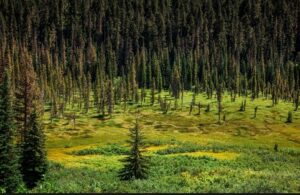Plant life and vegetation encompass the lush and diverse flora that blankets our planet, playing a vital role in sustaining life and maintaining ecological balance. From towering trees in ancient forests to delicate wildflowers in meadows, the world of plants offers a mesmerizing array of forms, colors, and adaptations. In this article, we embark on a journey into the fascinating realm of plant life and vegetation, exploring their significance, diversity, and ecological importance.

The Significance of Plant Life and Vegetation
Plants are the foundation of terrestrial ecosystems, serving as the primary producers that harness sunlight to convert carbon dioxide and water into organic matter through photosynthesis. This process not only provides food and energy for plants themselves but also forms the basis of the food chain, sustaining countless organisms, from insects to mammals.
Oxygen Production
In addition to producing organic matter, plants play a crucial role in producing oxygen through photosynthesis, releasing oxygen into the atmosphere as a byproduct. This process is essential for maintaining the balance of atmospheric gases and supporting aerobic respiration in animals, including humans.
Carbon Sequestration
Plants also act as carbon sinks, absorbing carbon dioxide from the atmosphere and storing it in their tissues. This helps mitigate the effects of climate change by reducing the concentration of greenhouse gases in the atmosphere and regulating global temperatures.
Diversity of Plant Life
The world of plants encompasses an astonishing diversity of species, with estimates ranging from 300,000 to over a million species worldwide. These include everything from towering trees in tropical rainforests to tiny mosses clinging to rocks in alpine regions.
Habitat Diversity
Plants inhabit nearly every corner of the globe, from the icy tundra of the Arctic to the steamy jungles of the Amazon. They have adapted to a wide range of environmental conditions, from extreme temperatures and arid deserts to nutrient-poor soils and saline marshes.
Morphological Adaptations
Plants exhibit a remarkable array of morphological adaptations to survive and thrive in their respective habitats. These adaptations include features such as deep root systems for accessing water, succulent leaves for storing moisture, and specialized structures for capturing sunlight or dispersing seeds.
Ecological Importance of Vegetation
Vegetation plays a critical role in maintaining the health and stability of terrestrial ecosystems, providing a multitude of ecosystem services that support life on Earth.
Habitat and Biodiversity
Plants provide habitat and food for a wide variety of organisms, from insects and birds to mammals and reptiles. They form the foundation of complex ecosystems, supporting intricate food webs and biodiversity hotspots.
Soil Stabilization
Plant roots help stabilize soil and prevent erosion, reducing the risk of landslides and maintaining soil fertility. In addition, the decaying organic matter from plants contributes to soil formation and nutrient cycling, enriching the soil and supporting plant growth.
Climate Regulation
Vegetation plays a crucial role in regulating local and global climates by influencing temperature, humidity, and atmospheric circulation patterns. Forests, in particular, act as carbon sinks, absorbing carbon dioxide from the atmosphere and helping to mitigate the effects of climate change.
Human Uses of Plant Life
Plants have been essential to human survival and civilization for millennia, providing food, shelter, medicine, and a myriad of other resources.
Food and Agriculture
Plants are a primary source of food for humans and animals alike, providing essential nutrients, carbohydrates, and proteins. Cultivated crops such as grains, fruits, and vegetables form the basis of human diets worldwide, while wild plants continue to be foraged for food in many cultures.
Medicine and Healing
Plants have long been used in traditional medicine systems around the world for their medicinal properties. Many modern pharmaceuticals are derived from plant compounds, and ongoing research continues to uncover new potential uses for plant-based medicines.
Economic and Cultural Significance
Plants have significant economic value, providing raw materials for industries such as timber, paper, textiles, and biofuels. They also hold cultural significance in many societies, playing roles in religious ceremonies, folklore, and traditional practices.
Conservation and Preservation
Despite their immense ecological and cultural importance, plant life and vegetation face numerous threats from human activities, including deforestation, habitat destruction, pollution, and climate change.
Biodiversity Conservation
Efforts to conserve plant biodiversity are crucial for maintaining the health and resilience of ecosystems and safeguarding the countless species that depend on them. Protected areas, botanical gardens, and seed banks play vital roles in preserving plant diversity and genetic resources for future generations.
Sustainable Land Management
Adopting sustainable land management practices is essential. Particularly for minimizing the impacts of human activities on plant ecosystems. Along with promoting their long-term health and viability. These practices include reforestation, sustainable agriculture, habitat restoration, and the protection of natural areas.
Climate Change Mitigation
Addressing climate change is paramount for safeguarding plant life and vegetation worldwide. Mitigation efforts such as reducing greenhouse gas emissions, and promoting renewable energy sources. Along with enhancing carbon sequestration through afforestation and reforestation. These are essential for mitigating the impacts of climate change on plant ecosystems.
Conclusion: A Celebration of Plant Life and Vegetation
In conclusion, the world of plant life and vegetation is a rich tapestry of diversity, beauty, and ecological significance. From the towering forests of the Amazon to the delicate wildflowers of the alpine meadows. Plants enrich our lives in countless ways, providing food, shelter, medicine, and inspiration. As stewards of the Earth, it is our responsibility to protect and preserve these precious resources. Effectively ensuring that the wonders of plant life continue to thrive and flourish for millennia to come.

